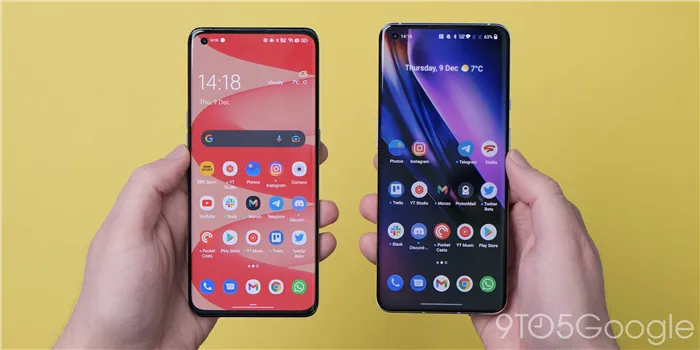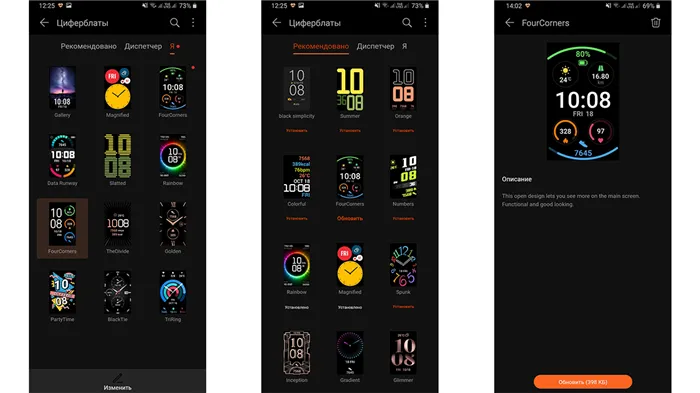We are aware of the issues caused by the OxygenOS 12 update and our software team is fixing them. We will suspend this software update and roll out a new iteration as soon as possible.
Что нового в бета-версии OxygenOS 12
С прибытием Android 12, различные бренды готовятся к выпуску обновлений для своих уровни настройки . Некоторые работают быстрее, чем другие. Это случай OnePlus , чья новая версия программного обеспечения находится в стадии бета-тестирования, и на некоторых устройствах она уже доступна.
OxygenOS для многих пользователей является слоем, который лучше всего оптимизирован для операционной системы Google. По этой причине ожидания относительно OxygenOS 12 довольно высоки. Благодаря бета-версии мы смогли проверить, какие из новости что дойдет до телефонов китайского бренда.
Персонализация по флагу
Различные дополнения, которые предлагает новая версия OxygenOS, обеспечивают полностью настраиваемый пользовательский опыт в различных аспектах. Таким образом, бета-версия доступна для самых мощных устройств фирмы: OnePlus 9 и OnePlus 9 Pro.
Как обычно, новые версии вносят изменения в дизайн. В течение нескольких лет, и даже если это было замечено сегодня в слоях других компаний, наблюдается тенденция к минимализм .
В случае с OxygenOS кажется, что они положили Помимо этой функции, новые значки имеют свет, тени и рельефы, которые создают трехмерный вид. Фирма назвала эту новинку пневморфизм .
Эта функция OxygenOS предназначена для тех, у кого есть несколько учетных записей в Facebook, Twitter, Instagram и других социальных сетях. Вместо того, чтобы постоянно выходить из одной учетной записи в другую, вы можете создать клонированную версию приложения, чтобы использовать обе учетные записи одновременно.
Launcher
The first thing you’re always greeted by is the launcher and the one in OxygenOS 12 has received several updates. In fact, it’s no longer the old launcher but rather replaced with the one from ColorOS.
OxygenOS 11 (left) vs OxygenOS 12 (right)
The most obvious change would be to the app icons. The new launcher has a more elaborate app icon customizer than its predecessor. By default, the icons now have a larger, squared-off design with rounded corners. You can choose between a couple more presets or enter the custom mode, which basically provides a few more shapes for the icons. Any third-party icon packs will also show up here but due to the side scrolling nature of this list, you may not know where they are unless you swipe sideways on the icons preset list.
OxygenOS 12 launcher options
Aside from that, you can now also adjust the icon size in a more fine-grained manner. You can also adjust the size of the app names or hide them completely. A change with OxygenOS 12 is that hiding the app icon names hides them on the home screen as well as the app drawer, whereas OxygenOS 11 would only hide them on the home screen. This behavior cannot be customized.
Speaking of the app drawer, it has also been updated and now shows fewer icons than before. A new option lets you change the sorting order and select multiple icons. The latter can be used to move a bunch of icons at once to the home screen or uninstall them in a batch. The second option is very convenient, and something other companies like Xiaomi have offered for a while.
App drawer (old left vs new right)
One annoyance with the new app drawer is that icons with names that don’t start with letters (e.g. 1Password) now appear at the bottom of the list rather than at the top before the alphabetical list. This is going to be frustrating to anyone used to how things worked in previous versions of the OS. This is also non-customizable.
The new launcher now allows disabling the app drawer and placing all icons on the home screen, iOS-style. This has been a staple feature on most other Android phones but something OnePlus never indulged in the past.
OnePlus has also changed the Hidden Space feature. This would previously appear to the left of the traditional app drawer but has now been turned into a secret vault of sorts that requires you to first set a passcode for it and then create a second code that needs to be entered through the dial pad of the Phone app to access the hidden apps.
Hide apps feature
This is useful if you really, really want to hide some of your apps and there’s also a separate app lock feature that features similar security hoops to set up and use. But the previous Hidden Space feature was a convenient way to quickly tuck away unnecessary apps and this new feature is way too complex for that while not offering a more convenient alternative.
OnePlus has also made the Google Feed page a permanent part of the launcher on the leftmost page. You get no say in this matter nor any option to replace it with something else.
Shelf (old left vs new right)
The Shelf feature has been updated with a new UI. This feature can now be accessed at any time by swiping down on the top-right edge of the screen. If you prefer not to use it, then it can be disabled from the settings.
Settings
The Settings app in OxygenOS 12 has also received several changes, putting it somewhere between OxygenOS 11 and ColorOS.
Settings (old left vs new right)
If you’re a dark mode user, you’ll notice that the background for the Settings app is now all-black instead of black with gray background around the settings categories. However, this behavior can be customized.
Dark mode settings
OxygenOS 12 dark mode lets you choose between all black, dark gray, and gray backgrounds. This affects only OnePlus apps, however, as third-party and Google apps simply switch to their own dark mode, whatever that may be.
Personalizations (old left vs new right)
A lot of sub-menus in the app have changed. One of them is the Personalizations screen. The options are still the same but are laid out differently. However, the way some of the options are applied has changed for the better. For example, changing the color theme, fonts, or icon packs now no longer quits all background apps. This was a frustrating aspect of OxygenOS 11, which meant if you did something basic as changing the color theme your music playing in the background would stop. Now, you may hear a slight stutter at times but none of the background apps are closed when making UI changes.
The screen color adjustments are now simpler. Aside from the usual Vivid and Natural (sRGB) presets, you get a Pro mode that lets you choose between Cinematic that claims the gamut to Display P3 and Brilliant, which unlocks the full-color spectrum of the display while throwing accuracy and color management out the window. You can adjust the color temperature of the display in any mode now but there is no longer a tint adjustment option available anymore.
Revised Dolby Atmos settings
Within the audio settings, the biggest change is to the Dolby Atmos mode. It now features scenario or environment-specific profiles. Within scenario-specific, you get the same options as before for smart, movie, music, as well as new gaming presets. The music preset can be customized further with a custom EQ. The environment-specific presets include indoor, on-the-go, commute, flight. For whatever reason, none of these seemed to make any difference, at least for audio played through Apple Music.
Navigation bar customization (old left vs new right)
One of the most useful features in OxygenOS 11 and prior versions was navigation bar customization. This lets those who still use the traditional navigation bar instead of navigation gestures to customize the three buttons by assigning various functions to a double-press or press and hold gesture. This feature was unceremoniously removed from the Nord 2 and it’s absent in OxygenOS 12 on the OnePlus 9 Pro as well.
This means that now the only customization you can do to the navigation bar is to swap the back and recent buttons. The navigation bar itself has been altered and the keys are now weirdly spaced out and placed awkwardly far from each other.
One-handed mode
If you do use gesture navigation, you can now access the new one-handed mode, which works similarly to that on iOS. It brings the top of the screen down, making it easy to reach. However, this mode is only available on the gesture navigation mode, adding further insult to injury for traditional navigation bar users.
In summary: OxygenOS as you know it is basically gone. This is a new software era for the Chinese firm that, like Realme and Vivo, is going to be tied directly to ColorOS. On top of that, it really doesn’t help that the first “stable” update based upon Android 12 for OnePlus phones is at times a bit of a buggy mess.
Bugs and bugbears

`
Update: OnePlus has since confirmed that the OxygenOS update has been pulled due to various bugs and issues:
We are aware of the issues caused by the OxygenOS 12 update and our software team is fixing them. We will suspend this software update and roll out a new iteration as soon as possible.
It’s not clear when we’ll see a reissue of the update but existing issues for those that have upgraded still remain.
For a so-called “stable” release, OxygenOS 12 is riddled with bugs and issues that honestly make it very hard to suggest that you update and install on your eligible OnePlus phone. It’s not even in just one or two areas either.
The system manages “locked” apps or apps that stay in RAM for quick access via the Recents menu. This leads to a frustrating situation whereby the “Close all” button within the app switcher simply won’t close every app. Having to dive into settings to disable this feels counterintuitive and a little shortsighted.
Earlier in the beta phase, notification status bar icons changed behavior. Swapping out simple, effective reminders for bright, colorful icons – rather than the line-style icons that we have become accustomed to on most Android devices. While this was jarring and didn’t fit with the rest of the system theming, some of the traits of this change remain.
Should you get multiple notifications back-to-back, OxygenOS 12 stacks these, and some will not show an icon within the status bar. Notifications can sometimes show in an incorrect order or be jumbled without reason. The way in which OxygenOS 12 handles notifications is pretty poor and compounds the problems that have been there for some time already.
One problem that isn’t unique to OxygenOS 12 but is annoying, all the same, is how the Always-on display handles the in-display fingerprint scanner. Often the guidelines for the scanner will just disappear, meaning you’ll need to tap your display to activate and then place your finger over the scanner again. Sure, that’s a nitpick, but it’s an annoyance all the same to the point it feels almost like a bug.
OxygenOS 12: Added Android 12 features
As you’d expect, a ton of changes added in the AOSP build of Android 12 have jumped over to Oxygen OS 12, and almost all were present in the early beta phase. Most are verbatim copies of what you’ll find on Pixel phones, with the Privacy Dashboard and enhanced camera and microphone access toggles also making the jump.
You’ll get an upper-right notification “dot” to indicate that your camera or microphone has been accessed. Expanding the notification shade and tapping the little icon will bring up another pop-up that tells you just which app has recently accessed your on-device hardware. It’s great for accountability, and being able to block access to the microphone and camera with the tap of a notification shade toggle comes in very handy.
OnePlus Shelf and the Scout feature are not technically new, but the extra control panel has received a facelift with the global search option also now available in all regions. This is a great place to stash Android widgets if you prefer not to clutter your homescreen but can be disabled completely. While you can no longer replace the Google Discover Feed, the Shelf portion is still well implemented and offers a unique take for common data points and quick access panels.
OxygenOS 12 tunes the impressive gaming modes available here too, with some notable new tweaks such as a voice modulator for in-game chat. This allows you to change your voice pitch for better anonymity when playing online titles. We can’t for certain say how well it works, but it’s an interesting addition and one that adds an extra “fun” layer to mobile gaming.
There is also a new “Data Monitor” option that gives you a draggable pop-up to manage and check your phone’s vital stats such as screen framerate, GPU, and CPU utilization. If you see performance dips, this can be a good way to keep track of your favorite titles. In the past, we’ve suggested that a OnePlus device can offer a better experience than many dedicated gaming phones and this still appears to be the case in many regards.








